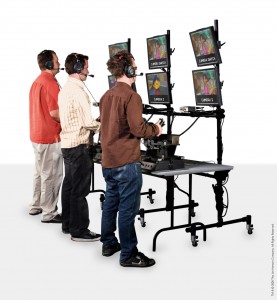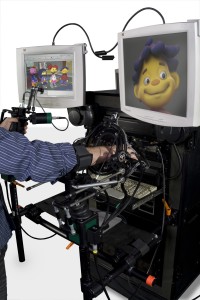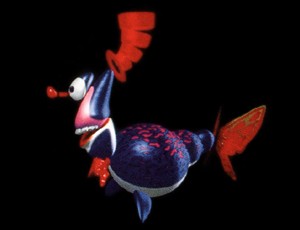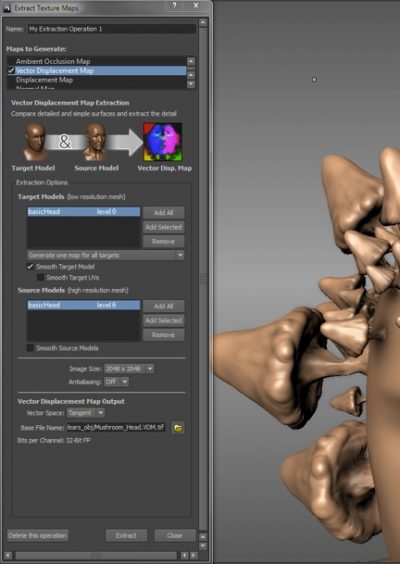Kids show with very adult tech. Sid the Science Kid from Jim Henson Studios is a remarkable project for the complexity and simultaneous simplicity of its motion capture. fxguide spoke to Steffen M. Wild, Visual Effects Supervisor, Digital Supervisor at Jim Henson Co. for this week’s fxpodcast.
The Jim Henson Company Creature Shop is behind a new series which debuted on PBS called Sid the Science Kid. It’s a morning program aimed at young children about science, but the technology behind it is a very complex system of mocap, digital puppetry, virtual photography all in real time allowing them to produce each episode as if is a live-action sitcom. The team use Motion Analysis, Final Cut, Maya and some proprietary tools to pull it all together. It’s an innovative system with deep roots as Jim Henson himself envisioned something like this in the early ’80s.
fxguide spoke to Steffen M. Wild, Visual Effects Supervisor, Digital Supervisor for this week’s fxpodcast.
Steffen Wild was born in 1966 in Erlangen, Germany. With his background in graphic-design and photography he studied film production and digital imagery at the Filmakademie Baden-Wuerttemberg in Ludwigsburg, Germany.
Steffen worked as a Digital Effects Artist/Producer for commercials and digitally created visual effects for TV and features in Europe for over 10 years. Steffen moved to Hollywood in 1995 to work on the academy award winning visual effects for Independence Day and worked for facilities such as the Computer Film Company and Pacific Ocean Pos and later Centropolis Effects.
In 2007 Steffen joined the Jim Henson Co. as the studio’s Digital Supervisor and helped to further build and stream-line the company’s Digital Pipeline for its Digital Puppeteering Studio. He is currently functioning as Digital Supervisor on the Henson produced, Sid The Science Kid.


What makes the Hensons system different from other systems is the aim to be able to direct the action much like a live action sit-com. Rather than just reviewing crude wire frames – or just capturing the motion of the performance actor, on Sid there are a team of puppeters on each character producing a virtual environment complete with facial animation all in real time.
Note the separate face and body controls are combined into a realtime preview.

As Steffen Wild discusses in this week’s podcast, Jim Henson himself pioneered realtime digital puppet work some 20 years ago with a character digitial character “Waldo” .
At Siggraph 89 in Boston Graham Walters, outlined how Waldo worked: As early as 1985, Jim Henson Productions had been trying to create computer graphics versions of their characters. They met with limited success, mainly due to the limited capabilities of the technology at that time. Finally, in 1988, with availability of the Silicon Graphics 4D series workstation, and with the expertise of Pacific Data Images, they found a viable solution. By hooking a custom eight degree of freedom input device (a kind of mechanical arm with upper and lower jaw attachments) through the standard SGI dial box, they were able to control the position and mouth movements of a low resolution character in real-time. Thus was Waldo C. Graphic born. Waldo’s strength as a computer generated puppet was that he could be controlled in real-time in concert with real puppets. The computer image was mixed with the video feed of the camera focused on the real puppets so that everyone could perform together. Afterwards, in post production, PDI re-rendered Waldo in full resolution, adding a few dynamic elements on top of the performed motion.
Waldo’s strength as a computer generated puppet was that he could be controlled by a single puppeteer (Steve Whitmire) in real-time in concert with conventional puppets. The computer image of Waldo was mixed with the video feed of the camera focused on physical puppets so that all of the puppeteers in a scene could perform together. Afterwards, in post production, PDI re-rendered Waldo in full resolution, adding a few dynamic elements on top of the performed motion. Waldo’s design was led by Kirk Thatcher with input from a variety of other artists, including Timothy Young and animated by Pacific Data Images, now known as PDI/DreamWorks. Jim Henson performed him in a special demonstration of how he worked in “Secrets of the Muppets.” (Source muppet.wikia.com)
The Jim Henson Company for Sid has partnered with KCET to produce this new educational series. The animated series showcases the Henson Digital Performance Studio. “Sid the Science Kid” is a unique sketch-comedy show designed for 3-6 year olds and aims to promote science-readiness and critical thinking skills. The series stars Sid, an inquisitive young boy attempting to demystify his quirky observations of the world around him.
Longtime Henson performers and Muppeteers, Drew Massey or Misty Rosas are bringing the character of Sid to life.
Drew Massey film credits include Muppets Wizard of Oz, The Producers, Doctor Dolittle, Cats & Dogs, Team America, and Men In Black I and II. Rosas’ credits include gorilla portrayals in Congo and Instinct, an alien in Altered, and stunt work on Jingle All the Way, Van Helsing, Practical Magic, and the motion-capture feature Monster House.
In addition to simply supplying the character’s voice, Massey performs the digital puppet in real time. The digital puppeteering provide the show with its fresh performances and spontaneous connections among characters. The series aims to combine the fresh look of CG Characters with the energy and interactions of traditional puppets, while remaining cost effective and efficient enough for children’s educational television. An area Henson’s know more about than perhaps any other company in the world.
Bradley Zweig is serving as head writer for the show, and episodes are being directed by Brian Henson. The half-hour series is on PBS in September with an initial order of 40 episodes along with a two-year on-air commitment.

